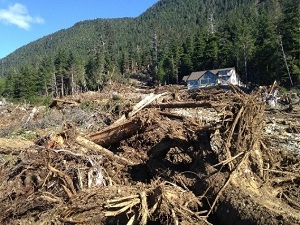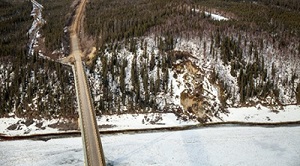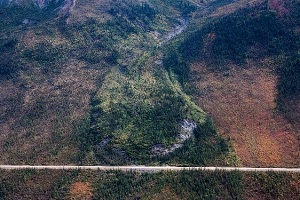A landslide is the down-slope movement of earth material, under the influence of gravity, due to ground failure. Landslide potential depends on a number of factors, including topography (slope), geology, lithology (rock or sediment type), vegetation, and water. In Alaska, degrading permafrost, steep slopes, heavy rain, retreating glaciers, ground-shaking from earthquakes, and isostatic rebound are important mechanisms that can trigger devastating landslides.
In general, landslides are classified based on the material type being transported and the mechanics of how the material moves. Transported materials include rock, soil (fine-grained material), and debris (coarse-grained materials) that move downslope by fall, slide, or flow. Landslides are often complex, involving multiple types of movement and material, and may begin as one type of mass movement and evolve into another as material moves downslope.

Deadly August 2015 landslide near Sitka, Alaska.
There are many examples of landslides that have significantly impacted Alaska. These include the numerous ground failures that resulted from the 1964 Great Alaska Earthquake, which were particularly significant in and around Anchorage.
In August 2015 there were more than 60 landslides in and around Sitka after heavy rains inundated the region. These landslides resulted in three fatalities and substantial damage to infrastructure, including roadways and homes. Landslides are common in Southeast Alaska and the U.S. Forest service has documented thousands of these features in Tongass National Forest.
A December 2018 landslide on the Seward Highway, south of Anchorage, resulted in road closure while material was removed and the area was inspected to ensure safe travel.
In 2004, an area of the Alaska Highway near Northway was rerouted because of a slope failure.

Landslide on the west side of the Dalton Highway, south bank of the Yukon River.
Planning is underway to reroute the Dalton Highway in the southern Brooks Range due to slow-moving permafrost-related landslides—known as frozen debris lobes—that are threatening the highway. The Alaska Department of Transportation & Public Facilities (DOT&PF) frequently deals with roads impacted by slope instability and has web sites with information along the state's road system (Unstable Slopes in Alaska; AKDOT&PF's Geotechnical Asset Management Program).

Frozen debris lobe FDL-A approaching the Dalton Highway in the southern Brooks Range.
Because landslides can potentially impact people and infrastructure in Alaska, DGGS conducts studies to evaluate unstable slopes and provide valuable information to policy makers, state and federal government agencies, and the general public.
Recent DGGS projects have assessed geotechnical characteristics relating to a landslide that occurred in September 2012 near the Dalton Highway bridge over the Yukon River; evaluated unstable slopes in a historically problematic area of slope failure along the Richardson Highway south of Glennallen; and investigated alpine-sourced debris flows along the Haines Highway in an area of frequent rock fall.
DGGS is currently involved in a number of landslide assessment and monitoring projects in Alaska, including: